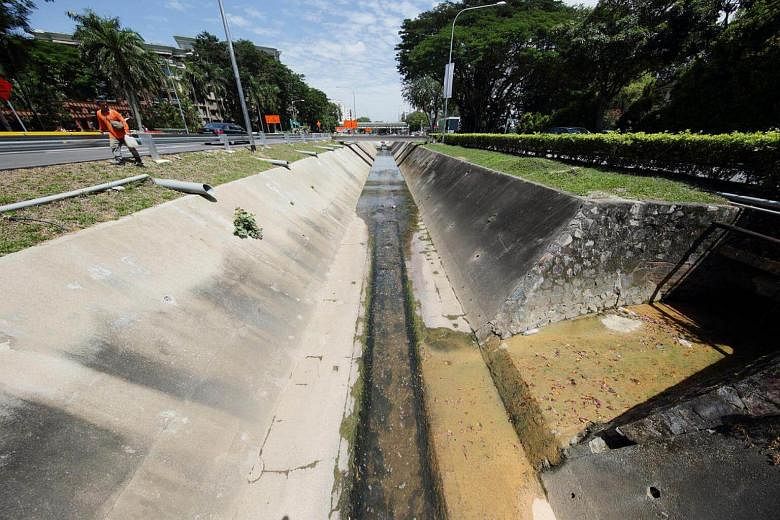The Bukit Timah Canal, sandwiched between two major roads along a transportation axis that has existed since 1845, is an almost accidental oasis of water and greenery that soothes the senses of many a traveller along its tree-lined banks.
When one considers its length of more than 7km as an open canal flanked by Bukit Timah Road and Dunearn Road from Jalan Anak Bukit to Newton, it is no wonder that representatives from nature groups here are seeing its potential for enhancing the urban environment.
Dr Shawn Lum, president of the Nature Society (Singapore), said he has been toying with the idea for some years, and thinks the Bukit Timah Canal could be a link within an even broader landscape of interconnected green pockets.
Mr Zac Lim, biodiversity manager at the Singapore Environment Council, said: "The Bukit Timah Canal offers immense greening opportunities, given its ideal location connecting the Singapore Botanic Gardens and the Green Corridor."
Besides the Botanic Gardens and Green Corridor, there are many other green pockets near the canal, such as the former Turf Club, the Bukit Brown area, Bukit Timah Nature Reserve and Clementi Woods.

Dr Lum said the clear beneficiaries of such corridors through the Bukit Timah area would be Singapore's native tree species. He believes surplus seeds and seedlings from trees in the forest could be collected, grown in a nursery and planted along Bukit Timah Canal and other strategic locations.
"If the trees are planted in clusters at distances less than 500m apart, many of our pollinator species should be able to traverse these distances and facilitate cross-pollination."
And there is a whole array of potential pollinators, including bees, nectar bats, hawkmoths, birds and butterflies, although only the hardier species might be able to use the corridor. This might nevertheless help connect trees in Bukit Timah Nature Reserve with those in places as far afield as the patch of rainforest in the Botanic Gardens, said Dr Lum.
"Studies carried out across the tropics have repeatedly shown that pollinators can facilitate pollen movement even across a fragmented landscape."
Mr Oh Cheow Sheng, group director of Streetscape at the National Parks Board (NParks), said: "NParks has intensified tree planting along parts of Bukit Timah Canal in the past years to create more vegetation tiers, resembling the forest structure, making it more conducive for biodiversity and enabling it to serve as a nature way."
An additional feature of the Bukit Timah Canal is its water, which adds another dimension.
Retired oil-rig worker Wong Thu Im, 68, who has lived along the canal near Hua Guan Avenue for more than 50 years, said a long time ago the canal had a muddy bottom, and its sides were covered with grass and soil. It was a more natural "ecosystem", with an abundance of birds, butterflies and fishes.
When The Sunday Times visited the canal last week, it was by no means devoid of aquatic life in clear flowing water, with underwater plants and fishes along some stretches. A damselfly was also spotted flitting along the surface.
The canal passes under local architectural treasures too, like the 1932 steel truss bridge carrying the former railway track to Malaysia.
Of late, parts of the canal have experienced, literally, an upheaval, with trees removed for the construction of Downtown Line 2 and canal improvement works.
Mr Wong, whose house sits along a stretch of the canal near King Albert Park that has been cleared of trees, hopes that the roadworks there would be completed soon and the trees would be planted back.
The place is hotter now without them, and residents in the area are complaining that there are no more birds singing, he said.
"People are waiting for the trees to come back. Now the heat comes off the road like a mirage."
The Land Transport Authority said the roadworks will be completed in October this year.
The greenery along the canal has also given some magic to Italian al fresco dining. Mr Carecci Salvatore, chief executive of Pasta Fresca Da Salvatore, 63, opened his restaurant in Bukit Timah Road in 1988.
His patrons enjoy a panoramic vista of raintrees lining both the road and canal. "I liked this location from day one because of the trees, the ambience," he said. He added that the trees have grown a little older and bigger since, and that his customers find them very beautiful.
"The trees absorb noise. The traffic noise would be worse without them. I hope it stays this way."
A spokesman for national water agency PUB said: "There is potential for the Bukit Timah Canal to be turned into a recreational space while still serving its main purpose as stormwater infrastructure."
He added that it would require careful assessment and be coherent with longer-term national plans for drainage improvement.
Mr Mycle Castle hopes for a cycling lane to make life easier for the many recreational cyclists who pass through the area. The 40-year-old bicycle mechanic, who works at BikePlus near the Sixth Avenue junction, said he was badly injured a few months earlier when he collided with a truck while cycling amid the heavy traffic along Bukit Timah Road.
Correction Note: An earlier version of this story said that the biodiversity manager at the Singapore Environment Council is Mr Zac Tan. It should be Mr Zac Lim. This has been corrected


